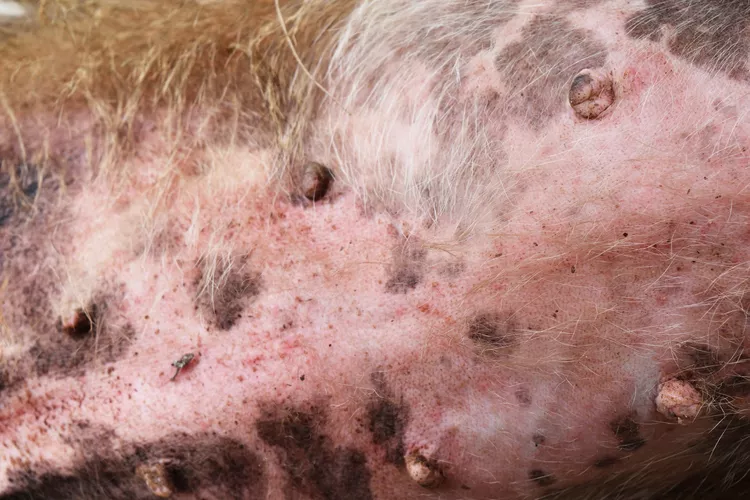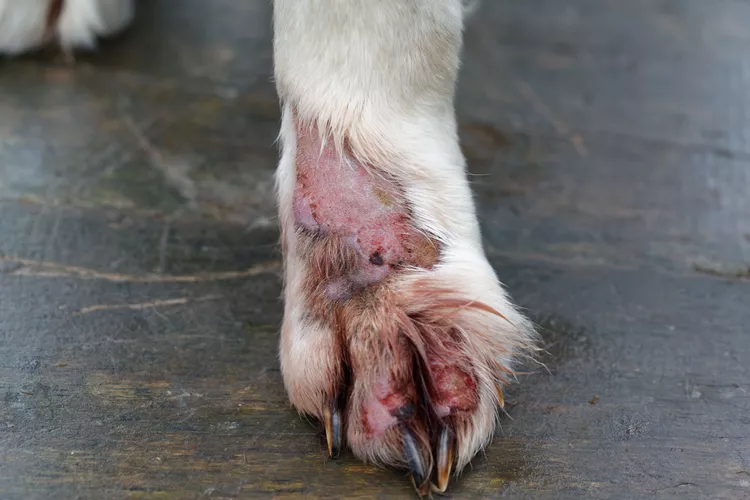Discover effective solutions for treating dog skin infection with antibiotics. Learn about common Dog antibiotics for skin infection prescribed by the veterinarian, their proper usage, potential side effects and other alternative approaches to promote healthy dog’s skin. Trusted insights on administering medication, recognizing signs of skin infection and speedy recovery for your canine. Elevate your understanding on dog care with experts’ advice on antibiotic for the canine skin issues.

Table of Contents
Dog antibiotics is a type of medication prescribed for dogs. They work by killing bacteria and protect the animal from the bacterial attack. Antibiotics help in keeping the bacteria from growing and increasing in numbers.
There are several types of antibiotics with different symptoms that treat a range of illnesses. Under the diagnoses of veterinarian your dog can be treated with antibiotics for a variety of illnesses caused by bacteria.
“To protect animal health and welfare, prevent and relief animal suffering” – Tom Meyer
It is a saying of a famous veterinarian on animal welfare and society. He took the oath and promises to serve the animal welfare and society as it is a noble profession that demands a selfless commitment to serving the needs of animals.

We the “Petscaresmasters” recommend you serve your animal/pet with the best treatment, go through this article, and explore the wide range of antibiotics and questions associated with them.
What skin infection causes dogs to rely on antibiotics?
Skin infection is caused by bacterial and fungal attacks. Apart from that, environmental exposure, contact with mud and grass or a certain injury causes skin infection.

Contact with the above-mentioned germs and viruses causes a disease called Pyoderma. Pyoderma is caused by uncleanliness or too much contact with bacteria. Pyoderma is a skin infection which creates pus in the skin and hair follicles.
Hair follicles are pimples that is grown on each hair and causes inflammation in the skin. If the treatment is not taken on time this disease can cause hair loss and shedding of hair from the dog’s skin.

As this disease is easily diagnosed since it is visible, pet owners should immediately shift their pet to medication and antibiotics.
Top-10 antibiotics to treat dog skin infection:
- Cephalexin
- Clindamycin
- Gentamicin
- Metronidazole
- Enrofloxacin
- Tetracycline
- Amoxicillin
- Doxycycline
- Cefpodoxime
- chloramphenicol
Cephalexin
Uses
Cephalexin is used to protect the dog from bacterial infection. It is used to treat the following infections:
- Ear infection
- Skin infection
- Urinary tract infection
- Respiratory infection
Side Effects
When feeding your dog with Cephalexin antibiotic, some of the indicators needs to be noticed as it can have certain side effect on your pet. Some of the side effects occurs due to:
- Over-dosage
- Microbiome imbalance
- Inappropriate antibiotic choice
Therefore, the side effect has the following impact:
- Nausea
- Diarrhea
- Vomiting
- Skin rashes
- Panting
Therefore, it is recommended to diagnose the disease through veterinarian and after fully diagnoses feed your dog with the appropriate antibiotic to avoid the above side effect impact.
How much to feed Cephalexin to dog in a day?
10 to 15 mg per pound twice daily for a healthy dog. If the dog is suffering from kidney failure, it is recommended to reduce the dosage.
Is Cephalexin suitable for puppies?
Cephalexin is suitable for puppies, middle age, and senior dogs. It helps in treating skin infection, respiratory tract, and urinary tract. This drug is approved by the FDA for use in humans and in dogs and is safe.
Clindamycin
Uses
Clindamycin is used for dogs in order to protect them from the following:
- Bacterial infection
- Wounds
- Pyoderma
- Bone and dental infection
- Abscesses
Side Effects:
The side effects caused by Clindamycin is because of the following:
- Inappropriate dosage
- Inappropriate antibiotic choice
- Genetic issue
Therefore, when feeding your dog with any antibiotics always consult a veterinarian for a physical diagnosis. It will help in the appropriate selection of the antibiotic and will help in the appropriate dosage.
The side effect caused by Clindamycin has the following impact:
- Gastrointestinal upset (Digestive upset)
- Vomiting
- Diarrhea
- Occasionally bloody diarrhea
How much does Clindamycin do to dog in a day?
The dosage amount varies depending on the infection. We the “Petscaresmasters” recommend daily dosage amount range from 5mg to 30mg per pound. It is split into two doses a day.
It is essential to consult a veterinarian and follow the instructions carefully as he will recommend after a physical diagnosis.
Is Clindamycin suitable for puppies?
Clindamycin is FDA approved for use in dogs. If the appropriate dosage is not available through veterinary pharmaceutical manufacturer, it may be compounded by specialty pharmacy. In this case the compounded products may improve palatability.
Gentamicin
Uses
Gentamicin is used for the dogs in order to protect them from the follow infections:
- Susceptible outer ear infection
- Eye infection
- Skin infection
This antibiotic is used to protect the outer eye and outer ear skin of the dog from bacterial infection.
Side Effects:
There are several side effects caused by Gentamicin antibiotic if the dosage is not appropriately used.
- Increased thirst
- Hair shedding and hair loss
- Decrease in muscle mass.
- Increased urination
- Thinning skin
To avoid the above side effects, follow the veterinarian guidelines properly to cure bacterial infection and to avoid the side effects.
How much to feed Gentamicin to dog in a day?
When your dog is on medication, never administer it without consulting a veterinarian. The usual doze in dogs is 5-7 mg per pound every 24 hours.
As this antibiotic has physical side effects like hair shedding or urination disturbance, dosage is planned accordingly to avoid the above-mentioned side effects that needs to be followed by the pet owners properly.
Is Gentamicin suitable for puppies?
Gentamicin is FDA approved only for the use of dogs. It is generally used to treat infections like outer ear infection, skin infection and eye infection. It is suitable for puppies and can help in their treatment.
Metronidazole
Uses
Metronidazole is also known as (Flagyl) which is feed to dog in order to reduce the risk digestive disturbance. It is famous antibiotic that veterinarian usually recommends in order to cure the following symptoms:
- Diarrhea
- Inflammatory bowel disease
- Mouth infection
- Infected gums
- Skin infection
Side Effects:
As Flagyl is used to treat stomach upset therefore, the dose should be given timely and according to the veterinarian’s guideline in order to avoid the inverse reaction.
Some of the side effects caused by Metronidazole is as follows:
- Nausea
- Vomiting
- Drooling
- Decreased appetite.
- regurgitation
It is an antibiotic that has multiple functions like treating skin infections and stomach related issues. We the “Petscaresmasters” recommends you follow the proper veterinarian guidelines in order to avoid any sort of mishap.
How much Metronidazole is it to dog in a day?
Metronidazole dose depends upon the condition of the dog. The range is from 10-30milligram/kg given two to three times in a day. If the condition of dog is severed or the infection is serious then the dog is on this medication for five to seven days or even one month or longer.
Over-dosage may lead to diarrhea, laziness, disorientation, rigidity, and stiffness.
Is Metronidazole suitable for puppies?
Metronidazole cause birth defects, it should not be given to pregnant animals in the first trimester. Furthermore, it should not be used in lactating animals as some metronidazole is excreted from breast milk.
For the overall well-development of the puppies most of the veterinarian recommends avoiding giving metronidazole to the puppies.
Enrofloxacin
Uses
Enrofloxacin, like other antibiotics, is used to treat susceptible bacteria in a variety of species. It is used to treat the following infections:
- Skin and soft tissues
- Urinary tract infection
- Ulcerative colitis
- Infections resulting from wounds.
- Respiratory system
Other than dogs, this antibiotic is also used in cats for their overall development and to protect them from bacterial infection.
Side Effects:
Some of the side effects caused by Enrofloxacin are due to inappropriate dosage or not properly following the veterinarian’s guidelines. The side effects caused by this antibiotic is as follows:
- Gastrointestinal effect
- Vomiting
- Diarrhea
- Lack of appetite
- Depression
- Uncoordinated walking
- Allergic reaction
How much Enrofloxacin is to feed dog in a day?
The Enrofloxacin dose for dogs is 50 to 20 mg/kg of body weight in dogs, or 2.27 to 9.07 mg per pound of body weight.
Enrofloxacin is given once or twice daily depending upon how severe the infection is. The selection of dose within the range should be based on clinical experience or what the veterinarian recommends.
Is Enrofloxacin suitable for puppies?
This medication should be avoided given to those puppies that are prone to allergy or skin sensitivity. Furthermore, puppies (8 months and younger) and senior dogs (18months and younger) should not be provided with this antibiotic.
The reason for avoiding giving Enrofloxacin to puppies and senior dogs is to reduce the risk of cartilage and tendon damage.
Tetracycline
Uses
Tetracycline is an antibiotic that is used to treat bacterial infections and inflammatory skin conditions in dogs such as lupus.
Lupus is a disease in dogs that causes a dog’s own immune system to attack multiple body tissues and organs. It can impact every organ in the dog’s body and can lead to skin infection.
Therefore, most veterinarians recommend this antibiotic to protect the dog’s immune system and protect the organ from failure.
Side Effects:
Tetracycline is rarely used to treat bacterial and skin infection. However, feeding your dog on this antibiotic can have adverse side effects.
- Nausea
- Vomiting
- Lack of appetite
- Diarrhea
How much Tetracycline is done to dogs in a day?
The usual dosage of tetracycline in dogs is 10mg/lb. every 8 hours. If the dosage is not given timely or is given under 8 hours, then it would have an adverse reaction.
If dosage is not given timely:
If the dosage is not given timely then it will not cure the infection, rather the severity of the infection would increase leading to complications.
If the dosage is given under 8 hours?
If the dosage is given under 8 hours, it would cause diarrhea, nausea, or digestive upset.
Rather than administering the dosage on your own, it is better to go with the clinical experience.
Is this antibiotic suitable for puppies?
Tetracycline and other medication in the class of tetracycline is not suitable for puppies or growing age dogs.
It causes problems with teeth and bones, as puppies are in the growing age developing their bones and teeth, this antibiotic can have an adverse reaction and can affect their growing age cycle.
Amoxicillin
Uses
Amoxicillin deals with varieties of infections such as
- Skin infection
- Bone infection
- Ear infection
- Dental disease
- Infected wounds
- Infected teeth
Apart from dealing with skin infections, it helps in the oral and well-development of dogs, protecting it from any skin infections to wounds and dental issues.
Side Effects:
When your pet is on Amoxicillin medication there are some of the side effects that your dog might show:
- Diarrhea
- Rashes
- Vomiting
- Swelling
- Fever
- Loss of appetite
- Difficulty in breathing
Due to certain antibiotic formulations dogs might show certain symptoms that have an adverse reaction. To deal with the adverse reaction, give your dog a proper diet and consult a veterinarian and properly follow the recommendation.
How much Amoxicillin does dog take in a day?
The dosage recommended by most veterinarians is 5-10mg per pound. This means that a 50-pound dog needs to take 500mg of this antibiotic twice a day.
The dose depends upon the severity of the infection, usually it is 10-14 days.
Is Amoxicillin suitable for puppies?
Amoxicillin is the most recommended antibiotic by veterinarians due to its effectiveness. It is suitable for puppies as it is safe in oral and protects from bacterial infections. This antibiotic is tolerant that puppies, middle-aged dogs, and senior dogs can rely on.
But feeding your pet on this medication has certain side effects that need to be tolerated. These are diarrhea, nausea, stomach pain or allergy.
Doxycycline
Uses
Doxycycline treats bacterial infections, but it is not effective in it. However, it helps the dog in treating the following infections:
- Dental disease
- Infected wounds
- Respiratory tract infection
- Heartworm disease
Side Effects:
Some of the common side effects that might occur in dogs are as follows:
- Vomiting
- Diarrhea
- Lack of appetite
- Digestive upset
However, these side effects can be reduced if proper medication guidelines are followed and along with that proper diet is given to the dog.
How much do you feed Doxycycline to dog in a day?
The usual dose of Doxycycline to feed a dog in a day is 2-5mg/pound. It should be given to the dog every 12-24 hours.
Is Doxycycline suitable for puppies?
Doxycycline should not be given to puppies, pregnant dogs, nursing dogs and dogs with liver disease. It is avoided in these categories of dogs as it can cause deformities or tooth abnormalities especially in developing puppies.
Cefpodoxime
Uses
Cefpodoxime is an antibiotic that is used to treat various infections listed below:
- Skin infection
- Urinary infection
- Respiratory infections
- Treat bacterial infection in various parts of body
- Prevent bacterial growth.
Side Effects:
Some of the side effects that are caused by feeding your dog with Cefpodoxime is as follows:
- Vomiting
- Decreased appetite.
- Diarrhea
- Lethargy
Usually, the side effects of the antibiotic occur because of not properly following the guidelines of the veterinarian. Therefore, it is recommended to make a proper diet plan of your pet and according to it follow your pet’s routine.
How much to feed Cefpodoxime to dog in a day?
Cefpodoxime is available for dogs in the form of 100mg and 200mg tablets. Therefore, the general dose is 5-10mg per kilogram of weight.
Depending upon on sever the infection is, veterinarian plans the dosage for dog that needs to be followed properly.
Is Cefpodoxime suitable for puppies?
Cefpodoxime is safe for dogs and puppies. A maximum of 10mg/kg for up to 28 days is considered safe for dogs and puppies.
If the dose is increased, then it might have an adverse reaction to the puppies like digestive upset or excess vomiting. Therefore, when it comes to medication, clinical experience is required.
Chloramphenicol
Uses
Chloramphenicol is an antibiotic that treats varieties of infections like:
– Gastrointestinal issues
– Urinary bacterial infection,
– Pulmonary
Furthermore, it also fights against anaerobic bacteria (that do not require oxygen to survive).
It is approved for use in dogs, follow your veterinarian directions and cautions very carefully and after it feed it to your pet to avoid adverse reaction.
Side Effects:
Some of the common side effects caused by Chloramphenicol are:
- Vomiting
- Diarrhea
- Decreased appetite.
- Pneumonia
If the infection is severed, doses are increased which might cause:
- Bone marrow
- Lethargy
- Paleness
- Weakness
- Lack of muscle coordination
Therefore, it is recommended to properly follow the veterinarian guidelines before taking your dog for medication.
How much does it take to feed Chloramphenicol to dog in a day?
The usual dose is 25mg per pound (50mg/kg) every eight hours for dogs.
Is Chloramphenicol suitable for puppies?
Chloramphenicol should be avoided given to puppies or senior dogs. It has adverse reactions like bone marrow and grey baby syndrome. As puppies are in developing age therefore, freeing them with this antibiotic will affect their overall development.
When it comes to old dogs, they have weak bones and weak immunity therefore, feeding them with this antibiotic will affect their bones and digestive system.
The above-mentioned are the dog antibiotics for skin infection, dental infection, or gastrointestinal issues. When a pet owner is going towards the medication there should be veterinarian advice that he needs to follow for proper dosage, accurate selection, and time.
How to feed antibiotics to dogs?
Antibiotics are available for dogs in three forms:
- Capsules
- Syrups
- powder
Capsules:
If feeding your dog antibiotics in the form of capsules, hide the capsule in a small amount of dog canned food or the food that you are feeding to your dog.
Without any resistance or hesitation, dogs will eat the antibiotic which will help in overcoming the infections that the dog is suffering from.
Syrups:
When feeding your dog with antibiotics in liquid form, create a pouch along the side of the mouth by gently pulling the lip away from the teeth. Slowly squeeze the syringe to dispense the liquid medication.
But when feeding your dog with liquid antibiotics, have the medication ready in place and carefully read the label and under the dosing instruction.
Powder:
Antibiotics that are available in powder form are either water soluble or can be mixed with food. If a pet owner is feeding antibiotics to his pet in the form of powder, then he should mix it with water and feed him when dog asks for water.
Other than that, a pet owner can mix powder antibiotic in the food of his pet and can feed him during the feeding hours.
This will help in the in-taking of the antibiotic and will cure the infections that the dog is suffering from.
Can over-the-counter antibiotics be useful for dog skin?
Over-the-counter antibiotic means purchasing the antibiotics without veterinarian prescription. We the “Petscaresmasters” recommend going with the antibiotic with the veterinarian prescription. The reason is that different infections need different antibiotics for healing.
Inappropriate use or selection may lead to antibiotic resistance or can worsen the condition. Over the counter is used to treat common scraps and scratches. If the infection is severed, go with the veterinarian prescription as he will provide you with the correct selection of antibiotics and correct dosage.
Can I stop taking antibiotics if my dog skin infection starts healing?
According to many experts and veterinarians, if the dog starts healing up its infection before the completion of antibiotic the pet owners should continue the course unless the antibiotic course is fully completed.
The reason is that if the antibiotic course is left uncomplete, the infection will not be healed and will affect the overall dog’s health and increase the complications.
Antibiotic alternates:
Some of the alternates of antibiotics are as follows:
- Probiotics support strong immunity and prevent certain infections.
- Topical Antiseptics containing iodine to heal up the infection.
- Nonsteroidal anti-inflammatory drug to reduce inflammation and provide pain relief.
- Using aloe-vera, coconut oil on skin infection for healing
Therefore, we the “Petscaresmasters” has provides the dogs antibiotic for skin infection, consult a veterinarian and under the proper diagnoses chose the appropriate medication for the overall development of your canine.




